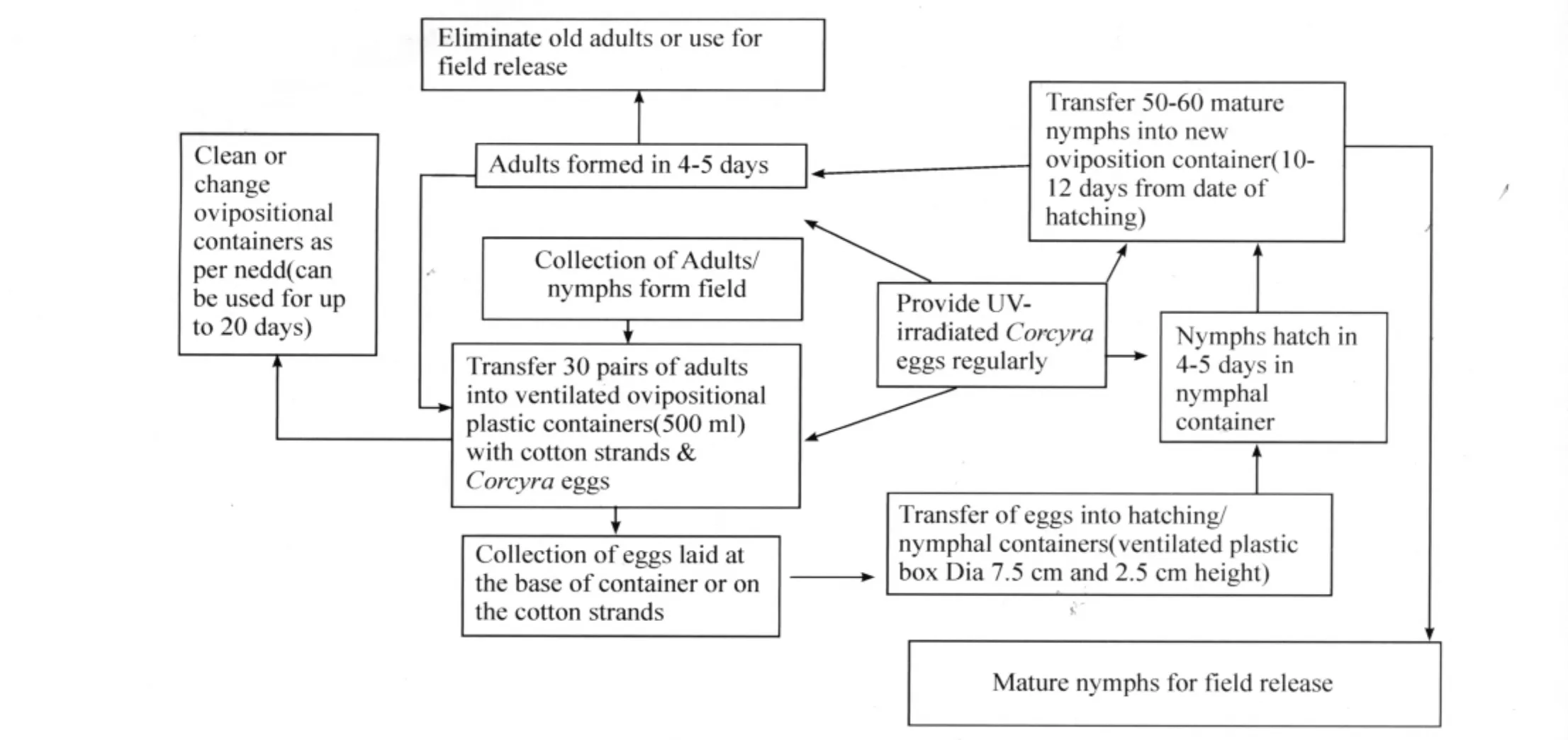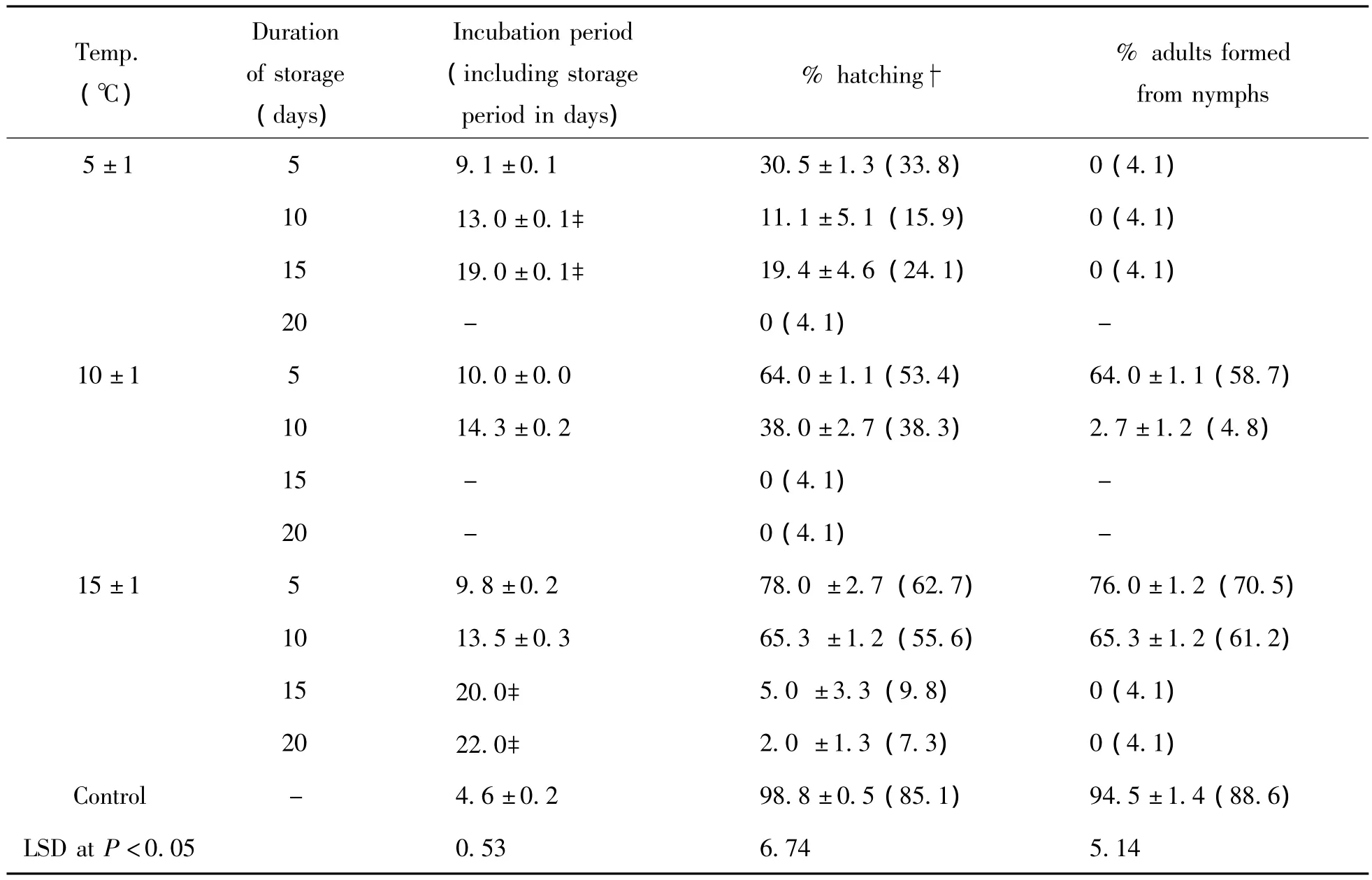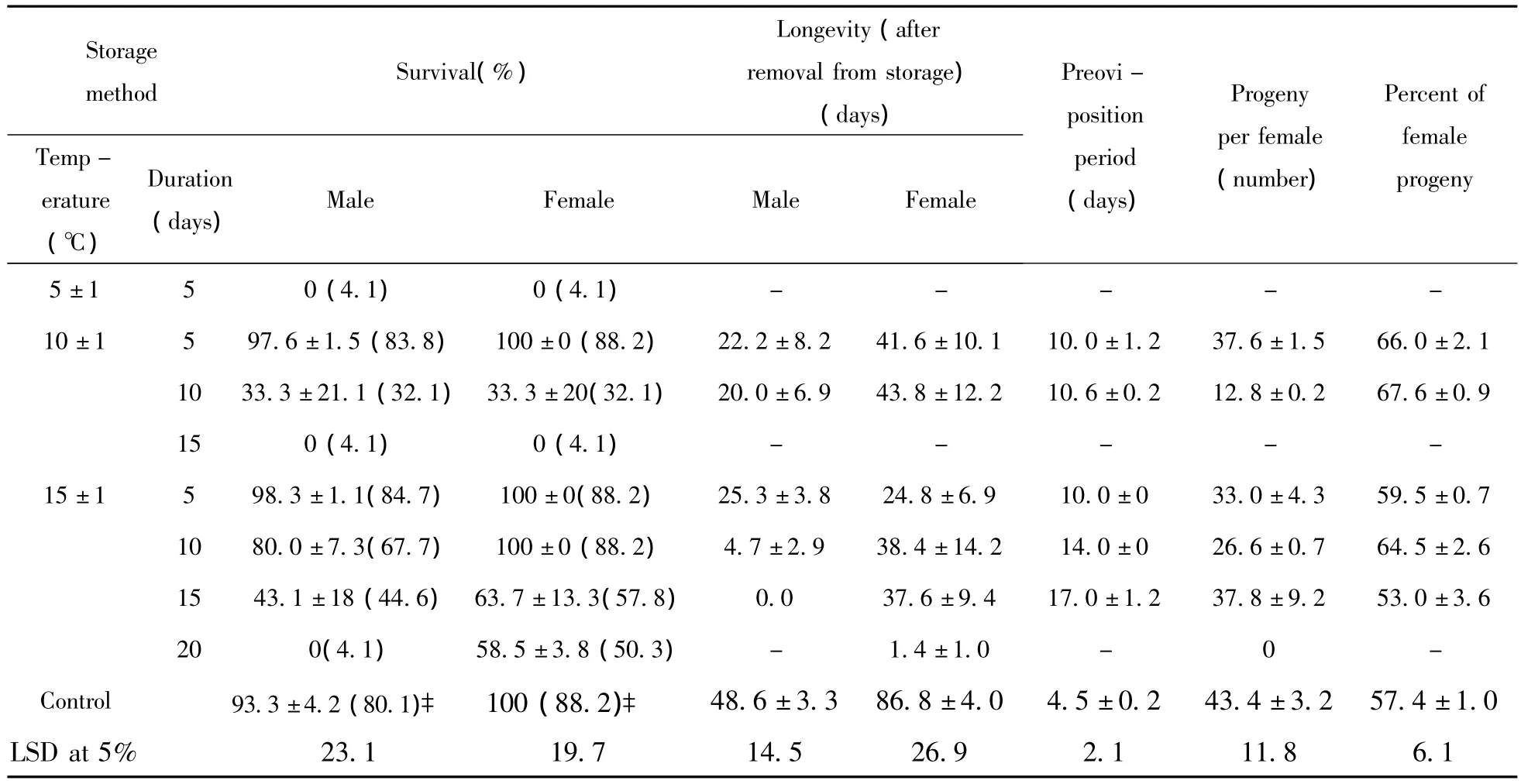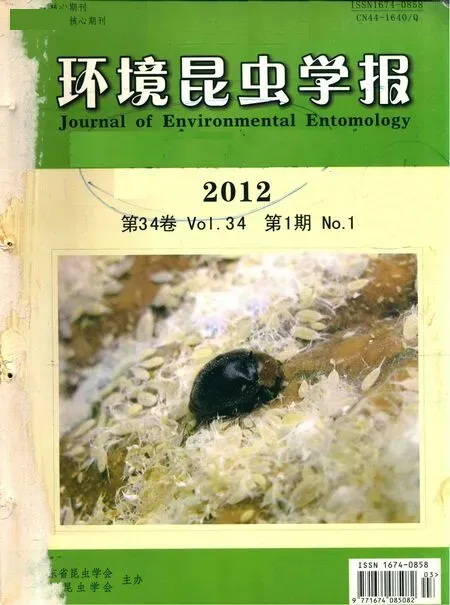Production protocol for and storage efficacy of an anthocorid predator Cardiastethus exiguus Poppius
1 Introduction
Cardiastethus exiguusv Poppius(=C.pygmaeus pauliani)was initially reported from nests of the Baya weaverbird Ploceus philippinus(Linnaeus)in south India by Muraleedharan(1975).Abdurahiman et al.(1982)reported for the first time the presence of C.exiguus in Kerala as predators of eggs and young larvae of the coconut black headed caterpillar Opisina arenosella Walker.At the National Bureau of Agriculturally Important Insects(ICAR),Bangalore,India,the culture of C.exiguus was originally collected from O.arenosella infested coconut plantations at Mandya and Mysore areas.Later a production protocol was developed for the same.This anthocorid could be multiplied on Corcyra cephalonica(Stainton)eggs(Ballal et al.,2003).Field releases of C.exiguus were carried out against O.arenosella in the states of Kerala and Karnataka,and the anthocorid proved to be a very efficient predator as the pest population could be suppressed when three releases of 50 nymphs/adults of C.exiguus were made at five day intervals(Lyla et al.,2006).The releases should however coincide with the egg laying stage of the pest.
Increased shelf life with little or no loss of post release effectiveness is being sought by researchers and commercial units who have to supply insects for control programs.Low temperature storage of parasitoids and predators is generally used to ensure the availability of insects to consumers,to synchronise a desired stage of development for peak releases and to provide flexibility and efficiency in production.Parker(1981)has detailed a method,wherein an anthocorid Anthocoris nemorum(Linnaeus)a potential agent for control of damson-hop aphid Phorodon humuli(Schrank)on hops were collected as adults from the field in early autumn and artificially overwintered,which were recovered in early spring.The nymphal stages of this predator were reared till they reached the desired instar for field release,then they were held in controlled cold storage till required.Though such research reports have indicated that diapausing stages of certain insects can be cold stored for long durations,based on specific situations and insects in question,it is equally important to identify optimum low temperatures and durations for short term storage of parasitoids and predators.Very few research papers are available on the storage efficacy of anthocorid predators.C.exiguus being a potential bio-agent which can target the eggs and neonates of O.arenosella,the need was felt to study the storability of the eggs and adults of this predator so that sufficient numbers could be accumulated for research and/or field releases.
2 Materials and Methods
2.1 Mass Production protocol for Cardiastethus exiguus
Based on the feeding potential and biological parameters of C.exiguus(Ballal et al.,2003),a protocol was designed to mass produce C.exiguus and the cost of production was worked out by including the cost of labour,infra-structure facilities and C.cephalonica eggs.
2.2 Storage of Cardiastethus exiguus eggs
Freshly laid eggs of Cardiastethus exiguus(which were laid amidst cotton strands in the oviposition container or on the walls and the base of the container)were chosen for the experiment and 10 eggs were placed in a round ventilated plastic box(diameter 7 cm;height 3 cm).Eight such boxes with C.exiguus eggs were stored in BOD incubators set at 5±1,10±1 and 15±1℃(60±5%RH)for different durations viz.5,10,15 and 20 days.The boxes were checked regularly for nymphal hatching.The nymphs were fed with UV - irradiated C.cephalonica eggs.Observations were recorded on the incubation period and percent hatching.When the adults formed,the percent adult formation in each of the treatments was recorded.A control batch of 10 eggs in eight replications was maintained at room temperature(26±2℃;60 ±5%RH),wherein all the above parameters were recorded for comparison.
2.3 Storage of Cardiastethus exiguus adults
The storability of C.exiguus adults at 5 ± 1,10±1 and 15±1℃ (60 ± 5%RH)for different durations(5,10,15 and 20 days)was studied in the laboratory.The adults(five pairs for each replication)were kept in ventilated plastic boxes(diameter 7 cm;height 3 cm)with feeding of UV irradiated C.cephalonica eggs.Six replications were maintained for each treatment.After removal from storage,the percent survival(of male and female adults)was recorded in each treatment batch.This was compared with the survival in the control batch(at 20 days from date of emergence),which was maintained at room temperature with the same number of replications and adult pairs per replication.
The surviving adults from each treatment batch were sexed and five pairs were maintained per replication and each treatment was replicated five times.These adults were fed with UV irradiated C.cephalonica eggs.The longevity of male and female adults,which were removed from storage,their progeny production(based on the number of nymphs observed)and percent female progeny produced were recorded for each treatment batch.A control batch was maintained at room temperature(26±2℃;60 ±5%RH)with the same number of C.exiguus adult pairs per replication,wherein total longevity,progeny production and female progeny production were recorded for comparison with the storage treatments.
The data obtained from the above experiments on storage of eggs and adults of C.exiguus were subjected to one way ANOVA and the means were compared by LSD test.Percentage data(where required)were subjected to angular transformation before subjecting to statistical analysis.
3 Results
3.1 Production protocol and cost of production and release
The step-wise production protocol is provided in Fig 1.The protocol and cost of production were worked out based on the biological parameters and feeding potential of the nymphal and adult stages of the predator(Ballal et al.,2003).
From 150 containers holding 60 adults(30 males and 30 females)in each,approximately 600,000 nymphs could be produced in one month.

Fig.1 Production protocol for Cardiastethus exiguus
Cost for 1000 nymphs=Rs.58/- (equivalent to US$1.29)(which includes the cost involved in production of Corcyra cephalonica eggs,manpower and other infrastructural facilities).
The recommended release rate is three releases@50 nymphs per tree.
At the above release rate,the cost of releasing 3800 C.exiguus nymphs in one acre of coconut plantation(with approximately 76 coconut trees)would be Rs 661(equivalent to US$14.7).
3.2 Storage of Cardiastethus exiguus eggs
3.2.1 Incubation period
The eggs of C.exiguus maintained at room temperature hatched in 4.6 days.When the eggs were stored at low temperatures of 5,10 and 15℃,the incubation period was significantly increased(df 5,42;F 341.84;P < 0.0001).By storing C.exiguus eggs for 5 and 10 days at 10℃,incubation period could be increased by 5 and 10 days,respectively,while at 15℃,the corresponding increase was 5 and 7 days,respectively,in comparison to control(Table 1).Percent hatching was very low when the eggs were stored for 10 and 15 days at 5℃and 15 and 20 days at 15℃,wherein the incubation period was recorded as 13,19,20 and 22 days,respectively(Table 1).
3.2.2 Percent hatching
At room temperature,98.8%of the eggs hatched.Low temperature storage led to a significant reduction in hatching(df 12,91;F 124.27;P<0.0001)(Table 1).At 5℃,the per cent hatching recorded was 30.5,11.1 and 19.4,respectively,after 5,10 and 15 days of storage,respectively,beyond which there was no hatching.Amongst the storage treatments,maximum hatching of 78%was recorded when the eggs were stored for 5 days at 15℃,which was on par with the hatching recorded in the 15℃ -10 days storage treatment(65.3%).The next best treatment was 5 days at 10℃ (64%hatching).Storage of eggs beyond 10 days at 15℃ and beyond 5 days at 10℃ led to significant reduction in hatching.The eggs of Orius sauteri(Poppius)laid in soybean sprouts were suitable for cold storage at 5℃,the hatching rate was more than 75%till 19 days of storage(Guo et al.,2002).Compared to C.exiguus eggs,the higher storability of O.sauteri eggs could be because these eggs are laid within plant material and hence can remain fresh for longer durations.
3.2.3 Percent adult formation
In the control batch,94.5%of the nymphs became adults.There was a significant reduction in the adult formation in all the treatment batches(Table 1)(df 9,70;F 364.56;P<0.0001).Very low or nil adult emergence was recorded from the storage treatments at 5℃,10℃ -10 days storage treatment and 15℃ -10 and 15 days storage treatments,indicating that these treatments were not suitable for egg storage.The best treatment was 5 days storage at 15℃,wherein 76%adult formation was recorded.This was followed by 5 days at 10℃ and 10 days at 15℃ (both being statistically on par).It was interesting to observe that a few eggs which were subjected to prolonged storage at 5℃ did not hatch,but they appeared to be fresh when observed under the microscope.This needs to be further investigated.
It is thus evident that it is detrimental to store C.exiguus eggs at 5℃ and at 10 and 15℃ for storage durations beyond 5 and 10 days,respectively.If an insectary is aiming for more than 50%hatching and adult formation,the above storage strategy may be followed.

Table 1 Effect of low temperature storage of C.exiguus eggs(Mean±SEM values)
3.3 Studies on Cardiastethus exiguus adults storage
3.3.1 Survival percentage
When adults were stored at 5℃,100%mortality was recorded after 5 days of storage.Low temperature storage of C.exiguus adult males at 10 and 15℃,beyond 5 and 10 days,respectively,led to a significant reduction in survival(df 8,45;F 19.09;P <0.0001)in comparison to that of control adults maintained at room temperature.Adult male survival was not significantly affected by storage for 5 days at 10℃and 5 and 10 days at 15℃ (P<0.05),survival percent values being 97.6,98.3 and 80%,respectively(Table 2).The same trend was observed with respect to adult female survival.Survival percentages recorded when the adult females were stored for 5 days at 10℃and 5 and 10 days at 15℃,were statistically on par with the control batch.Kim et al.(2009)reported that 10℃was the optimum low temperature for storing Orius lavigatus(Fieber)adults,as 70%of the adults could survive for 36 days at this temperature.Overwintered female adults of Oriussauteri(Poppius)could be stored at 7℃for two months at the end of which survival was 55%(Wang et al.,1994).In the present investigation,significant reduction in male and female adult survival was recorded when storage duration exceeded beyond 5 days at 10℃ and 10 days at 15℃.The adult females survived better at low temperatures in comparison to males.Beyond 10 days of storage at 10℃and 15 days at 15℃,no males survived.
3.3.2 Longevity
There was a significant reduction in the longevity of males which were removed from storage in comparison to the adult males which were maintained at room temperature(48.6 days)(df 5,24;F 11.98;P <0.0001).Amongst the treatments,maximum male longevity was recorded in the case of storage for 5 and 10 days at 10℃ and 5 days at 15℃ (22.2,20 and 25.3 days,respectively).Though survival of males stored at 15℃ for 10 days was 80%,the longevity of these males was very low(4.7 days).It was evident that adult males could not tolerate low temperature storage beyond 10 days at 10℃ and 5 days at 15℃(Table 2).Rudolf et al.(1993)reported that storage for 50 days at 13℃led to a reduction in life span of O.laevigatus adults.Unlike in parasitoids,in predatory insects,reduction in male longevity results in loss of functional biological control agents.

Table 2 Effect of low temperature for storage of C.exiguus adults(Mean±SEM values)
In general,females lived longer(86.8 days)than males(48.6 days).Low temperature storage led to a significant reduction in the longevity of adult females(df 6,28;F 7.58;P< 0.0001),which ranged between 1.4 to 43.8 days(Table 2).Except for the treatment where the adult females were stored for 20 days at 15℃,all the other treatments were statistically on par(P<0.05)with respect to female longevity.It was evident that adult females were more tolerant to low temperature in comparison to males.Wang et al.(1994)reported that O.sauteri could overwinter as either mated or unmated female adults,but not as male adults or nymphs.Guo et al.(2002)reported that adults previously reared at 15℃for 15 days and then stored at 5℃had a significantly higher longevity compared to the adults maintained at room temperature.
3.3.3 Pre-oviposition period
It is mentioned by Tommasini and van Lenteren(2003)that the pre-oviposition period is an indicator on how adult populations react to external stimuli.At room temperature,the mean pre-oviposition period of C.exiguus was recorded as 4.5 days.In the case of stored adults,the pre-oviposition period was significantly increased(df 5,24;F 34.5;P <0.0001)(Table 2).The maximum pre-oviposition period recorded was 15 days(15℃ - 15 days treatment),which was followed by the 15℃ - 10 days treatment,where the pre-oviposition period was 14 days.Significantly lower(P <0.05)pre-oviposition periods were recorded in the case of adults stored for 5 and 10 days at 10℃ and 5 days at 15℃,the values being 10.0,10.6 and 10.0 days,respectively.According to Ruberson et al.(1991)and van den Meiracker(1994),species of Orius enter into diapauses when the pre-oviposition period exceeds 14 days.In the present experiment,though a pre- oviposition period of 17 days was recorded in one of the storage treatments(15℃ -15 days storage treatment),progeny production was recorded in this treatment.
3.3.4 Progeny production
Progeny production by the females stored for 5 days at 10℃ and 5 and 15 days at 15℃ were all statistically on par with each other and with the control batch indicating that low temperature storage for the indicated durations did not affect the fecundity of the females.Guo et al.(2002)reported similar results with reference to stored O.sauteri adults whose fecundity was comparable to that of un-stored adults.However,Kim et al.(2009)observed that the fecundity of O.laevigatus adults stored for 10 to 50 days at 10℃was 15.3 to 53.7%of the normal fecundity.Generally,in insect storage studies,it is observed that biological parameters are adversely affected when the duration of storage increases.However,a significant reduction in progeny production observed in the 15℃10 days batch compared to the 15℃15 days batch could be due to some individual variations in the replication batches.It was interesting to observe that few adult females which were placed at 15℃for 20 days continued to survive,but they did not lay any eggs.More in -depth investigations have to be carried out on whether such a low temperature treatment could induce diapauses in C.exiguus.
3.3.5 Percent of female progeny
In the control batch,57.4%of the progeny were females.It was observed that storage did not adversely affect the female progeny production,which ranged between 53 to 67.6%(Table 2).Highest per cent female progeny was recorded in 10℃ -5 and 10 days storage treatments and 15℃ -10 days storage treatment,which were statistically superior to control at P< 0.05(df 5,24;F 7.26;P=0.0002).This appears to be a rare phenomenon,as it is generally observed that low temperature storage is detrimental to progeny production by the adult females.However,there are reports which state that cold storage could improve the life span,fecundity,quality of progeny and per cent female progeny of certain parasitoids(Legner,1976;Zhu Zhang,1987;Petters& Grosch,1977).In the case of O.laevigatus,fecundity was not reduced even after 50 days in storage,while in the case of Orius majuscules(Reuter),fecundity was substantially reduced after 20 days of storage(Rudolf et al.,1993).
Based on the present investigation,it can be concluded that C.exiguus eggs can be safely stored for up to 5 days at 10℃ and female adults for 5 days at 10℃and 15 days at 15℃.The storage temperature and duration can be decided based on whether the adults are required for culturing or for field releases.In certain anthocorid predators,cycling storage temperature between 3 and 13℃was observed to be better than maintaining at a constant 9℃ (Rudolf et al.1993).Simi-lar experiments on testing various temperature regimes could be attempted for storing C.exiguus eggs and adults.Parallel studies on photoperiodic effect on diapause induction in C.exiguus would be very useful for planning long term storage and thus to enable timely large scale inundative releases.
Acknowledgement
The authors are grateful to Director,NBAII and Indian Council of Agricultural Research for the facilities provided and the first author places on record her gratitude to CSIR&ICAR for the travel grant provided to present this paper at ISMC 2011 held at Beijing,China and to the organisers of ISMS2011 for the hospitality provided.
Abdurahiman UC,Mohammmed UVK,Remadevi OK,1982.Studies on the biology of a predator,Cardiastethus sp.(Hemiptera:Anthocoridae)found in the galleries of Nephantis serinopa Meyr.(Lepidoptera:Xylorictidae).Current Science,51:574-576.
Ballal CR,Singh SP,Poorani J,Gupta T,2003.Feasibility of mass multiplication and utilization of Cardiastethusexiguus Poppius,a potential anthocorid predator of Opisina arenosella Walker(Lepidoptera:Oecophoridae).29-33.In Biological Control of Lepidopteran Pests(Tandon PL,Ballal CR,Jalali SK,eds.)354.
Guo J,Wu M,Wan F,2002.Effects of cold storage on the adults and eggs of Orius sauteri.Chinese Journal of Biological Control,18:10-12.
Kim JH,Kim HY,Han MJ,Choi MY,Hwang SJ,Lee MS,2009.Cold storage effect on the biological characteristics of Orius laevigatus(Fieber)(Hemiptera:Anthocoridae)and Phytoseiulus persimilis Athias-Henriot(Acari:Phytoseiidae).Korean Journal of Applied Entomology,48(3):361 -368.
Legner EF,1976.The relationship between host destruction and parasite reproductive potential in Muscidifurax raptor,M.zaraptor and Spalangia endius(Chalcidoidea,Pteromalidae).Biocontrol,24:145 -152.
Lyla KR,Beevi P,Ballal CR,2006.Field evaluation of anthocorid predator,Cardiastethus exiguus Poppius against Opisina arenosella Walker(Lepidoptera:Oecophoridae)in Kerala.Journal of Biological Control,20:229 -231.
Muraleedharan N,1975.New record of Cardiastethus pygmaeuspauliani(Lansbury)from India.Newsletter,Zoological Survey of India,1:67.
Parker NJB,1981.A method for mass rearing the aphid predator Anthocoris nemorum.Annals of Applied Biology,99:217-223.
Petters RM,Grosch DS,1977.Reproductive performance of Bracon hebetor females with more or fewer than the normal number of ovarioles.Annals of Entomological Society of America,70:577 -582.
Ruberson JR,Bush L,Kring TJ,1991.Photoperiodic effect on diapause induction and development in the predator Orius insidiosus(Heteroptera:Anthocoridae).Environmental Entomology,20:786-789.
Rudolf E,Malausa JC,Millot P,Pralavario R,1993.Influence of cold temperature on biological characteristics of Orius laevigatus and Orius majusculus(Het:Anthocoridae).Entomophaga,38:317-325.
Tommasini MG,van Lenteren,JC,2003.Occurrence of diapause in Orius laevigatus.Bulletin of Insectology,56:225 -251.
Van den Meiracker,1994.Induction and termination of diapauses in Orius predatory bugs.Entomologia Experimentalis et Applicata,73:127-137.
Wang FH,Zhou WR,Wang R,1994.Studies on the overwintering survival rate of Orius sauteri(Hem.:Anthocoridae)in Beijing.Chinese Journal of Biological Control,10:100 -102.
Zhu DF,Zhang YH,1987.Cold storage of Trichogramma developed from fluctuating temperature.Natural Enemies of Insects,9:111-114.

